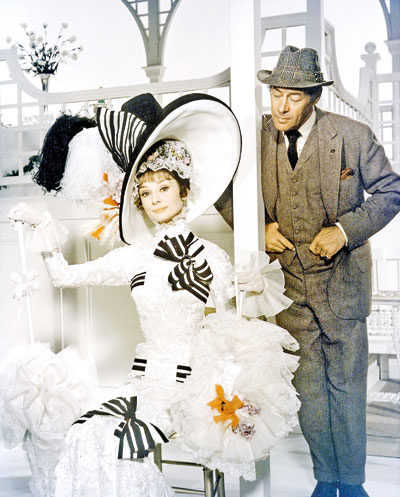‘Being Sane in Insane Places’ – The power of human labelling
“I read a book once that a rose by any other name would smell as sweet, but I’ve never been able to believe it. I don’t believe a rose WOULD be as nice if it was called a thistle or a skunk cabbage.” -L.M. Montgomery, Anne of Green Gables

Positive labelling: Eliza Doolittle trained by Professor Higgins to be a lady of class and distinction (Scene from My Fair Lady, a musical film based on George Bernard Shaw’s Pygmalion)
In one of psychology’s famous experiments, David Rosenham, a psychiatrist and seven of his colleagues admitted themselves to a psychiatric hospital. Prior to getting admitted, the group agreed that they would say the same things to the admitting doctor. They told the doctor that were hearing voices that said “empty,” “hollow,” and “thud.” These words do not have any psychiatric significance. But after a short interview, they were all admitted and given a diagnosis of schizophrenia or manic depression (also now called bipolar disorder). After admission to the hospital, they all behaved normally but took notes of their experience. They were held in the hospital for up to two months and discharged with a label of “schizophrenia in remission.”
An interesting fact was that out of 118 fellow patients, 35 identified them as normal but none of the medical staff suspected anything. In this case, the patients were more insightful than the doctors. Some of the normal behaviours of the researchers were interpreted as being abnormal. For example, their extensive note taking was labelled as compulsive behaviour. Rosenham published his findings in a book “Being Sane in Insane Places,” from which I have taken the title of this article.
The study caused a furore in the psychiatric community. This was in the days before objective criteria were formulated for diagnosing psychiatric disorders and one would hope that the accuracy of psychiatric diagnoses is better now. Psychiatric labels are useful in that it helps the doctor to better understand what a person is suffering from, determine the best treatment and give a more accurate prognosis. The problem with a label is that it can stick and make it difficult to think of a person as a human being rather than the description given by the label. This lesson was taught to me early when as a medical student I began my appointment in psychiatry in the same unit I now work as a professor. Our teacher pointed to a woman who was sweeping the ward and asked us what we thought her diagnosis was. We gave various answers from our limited psychiatric knowledge, such as depression, and schizophrenia. He then smiled and told us that the woman was actually the ward cleaning lady.
Labelling is not limited to psychiatry. Even in other specialities, labelling can be a problem. For example, we have diabetic patients, heart patients, pressure patients and cancer patients. How do we get around this problem? Again another lesson taught me by the same teacher as mentioned previously. He was the supervisor of my MD dissertation which was on the subject of alcohol and anxiety. I handed him the completed dissertation prior to submission for final corrections. He returned the dissertation and said it was fine but there was one problem. In several places, I had referred to the subjects of the study as alcohol dependent patients. He wanted me to change it to patients with alcohol dependence. This was in the days before computers and I had to laboriously change each individual reference, 14 in all, manually. But the lesson was learnt and I would remember it for the rest of my life. Patients are human beings, each more much more than the disease he or she may have.
 Labelling is not limited to psychiatry or medicine but is prevalent in our society. Let me illustrate with another famous study, this time in the field of education. Two psychologists Robert Rosenthal and Lenore Jacobson told teachers at an elementary school that they have through a special test, found that 20 percent of their students were “academic bloomers” who were expected to blossom intellectually in the coming year. Actually, no such test had been done and the students were chosen at random from their peers and had performed equally well on a genuine test of IQ. One year later they returned and were astonished to find that the so-called special children outperformed their peers by 10 to 15 IQ points. The teachers probably invested more time and energy on these children and the expectation of good performance enabled the children’s superior performance. Rosenthal and Jacobson later wrote their finding in a book titled Pygmalion in the Classroom. Pygmalion is a famous play by George Bernard Shaw where a bedraggled Cockney flower girl, Eliza Doolittle is trained by Professor Higgins to be a lady of class and distinction. An example of positive labelling.
Labelling is not limited to psychiatry or medicine but is prevalent in our society. Let me illustrate with another famous study, this time in the field of education. Two psychologists Robert Rosenthal and Lenore Jacobson told teachers at an elementary school that they have through a special test, found that 20 percent of their students were “academic bloomers” who were expected to blossom intellectually in the coming year. Actually, no such test had been done and the students were chosen at random from their peers and had performed equally well on a genuine test of IQ. One year later they returned and were astonished to find that the so-called special children outperformed their peers by 10 to 15 IQ points. The teachers probably invested more time and energy on these children and the expectation of good performance enabled the children’s superior performance. Rosenthal and Jacobson later wrote their finding in a book titled Pygmalion in the Classroom. Pygmalion is a famous play by George Bernard Shaw where a bedraggled Cockney flower girl, Eliza Doolittle is trained by Professor Higgins to be a lady of class and distinction. An example of positive labelling.
In another classic study done by psychologist John Darley, college students were shown a video of a young girl Hannah, who was shown as either being poor or wealthy. In one video Hannah was seen playing in a low-income neighbourhood and her parents were described as working class. In the alternative video she was seen playing in a wealthy neighbourhood with tree-lined streets and her parents were described as college educated professionals. Later when questioned about the academic ability of Hannah, the students who thought she was from a relatively wealthy family with educated parents stated she was probably at the fifth-grade level. The other group who thought Hannah was from a poor background stated she was below fourth grade.
The effects of negative labelling are not trivial. They can be quite harmful. Labelling prevents the person who sticks the label on an individual from seeing that person as a human being separate from the label. Persons given a pejorative label as foolish, ugly or miserable may lose motivation to change or better themselves and actually live up to their labels.
Let us take care when labelling people especially children who are sensitive to such labels. Though you may do so in fun, please remember you can do real long term harm.


